mobile Ansicht, to the English Version tap the flag
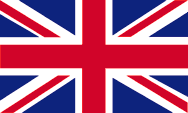

- Balearische Inseln
- Autonome Region Spaniens
- 1232–1343 Königreich Mallorca
- 1344–1714 Königreich Mallorca als Teil der vereinigten Krone von Aragon
- Eigenbezeichnungen:
– Spanisch: Islas Baleares
– Katalanisch: Illes Balears
• Flagge
• historische und andere Flaggen
• Bedeutung/Ursprung der Flagge
• Wappen
• historische Wappen
• Bedeutung/Ursprung des Wappens
• Landkarte der autonomen Regionen Spaniens
• Zahlen und Fakten
• Geschichte
• Ursprung des Landesnamens
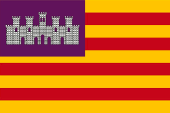
seit 1983,
Flagge der Balearen,
Seitenverhältnis = 2:3,
Quelle, nach: Flags of the World







1229–1715,
Flagge des Königreichs Mallorca,
Seitenverhältnis = 2:3,
Quelle, nach: Wikipedia (ES)



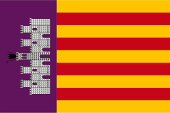
1978–1983,
inoffizielle Flagge der Balearen,
Seitenverhältnis = 2:3,
Quelle, nach: World Statesmen




Mallorca:

seit 1983,
Flagge von Mallorca,
Seitenverhältnis = 2:3,
Quelle, nach: Flags of the World





Menorca (Minorca):
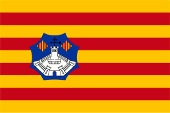
seit 1983,
Flagge von Menorca,
Seitenverhältnis = 2:3,
Quelle, nach: Flags of the World



Ibiza (Eivissa):
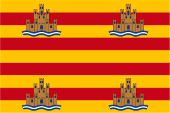
seit 1983,
Flagge von Ibiza,
Seitenverhältnis = 2:3,
Quelle, nach: Wikipedia (ES)



Formentera:
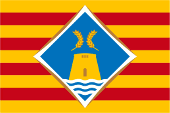
seit 2010,
Flagge von Formentera,
Seitenverhältnis = 2:3,
Quelle, nach: Wikipedia (ES)




Die heutige Flagge der Balearen wurde am 25.02.1983 offiziell eingeführt. Sie zeigt vier horizontale rote Streifen auf goldenem Grund und eine violette Oberecke in der eine Burg zu sehen ist. Das Motiv erinnert an die historische Flagge des Königreichs Mallorca. Im Jahre 1228 eroberte Jakob I., König von Aragon, die Insel Mallorca, bis 1232 war die Eroberung der Balearen abgeschlossen. Jakob I. gliederte die Inselgruppe als Königreich Mallorca seinem Herrschaftsgebiet an, er war der erste König von Mallorca. Die aus dieser Zeit überlieferten Wappen zeigten im Geviert vier senkrechte rote Streifen auf goldenem Grund (Aragon) und ein blaues Feld mit einer weißen Burg darin, was sich auch so auf Flaggen oder Bannern widerspiegelte, mal mit senkrechten mal mit waagerechten roten Linien. Diese Burg ist die Burg von Palma, der Almudaina Burgpalast, auch Almoraina genannt. Es ist ein in Palma seit der Zeit der Römer ein befestigter Platz in strategisch günstiger Lage. Die Araber (Mauren) errichteten hier im 10. Jahrhundert ihre Residenz, den Alcazar-Palast. Unter König Jakob II. wurde der Alcazar von 1305 bis 1314 zur Königsburg – dem heutigen Almudaina-Palast – umgebaut. Er dient noch heute als Residenz des Spanischen Königs wenn er auf Mallorca weilt. Im Jahre 1269 gestatte König Jakob I. der Universität von Palma seine eigene Flagge und sein eigenes Wappen zu verwenden. Als er 1276 starb, vererbte er sein Reich an seine beiden Söhne. Aragon verblieb bei seinem älteren Sohn Peter III., während sein jüngerer Bruder Jakob II. das Königreich Mallorca erbte und dazu noch die Grafschaften Roselló (Roussillon) und Cardanya (Cerdagne) und die Herrschaft Montpeller (Montpellier). Seine Hauptstadt wurde Perpinyá (Perpignan) in Roselló. Er übernahm das Wappen seines Vaters, jedoch zeigen die historischen Abbildungen von Wappen oder Bannern einen kleinen Unterschied. Die Anzahl der roten Balken verringerte sich auf drei. Flaggen oder Wappen mit diesem Bild nennt man heute "Tribarrada". Die Ursachen dafür sind nicht bekannt. Entweder wurde dem Abzählen der aragonesischen Balken damals keine Bedeutung beigemessen, oder Jakob II. war es wichtig eine eigene Heraldik zu schaffen, die sich von der seines Bruders unterschied. Ein weiteres heraldisches Bild, das mit dem Königreich Mallorca in Verbindung gebracht wird ist das übliche Wappen von Aragon mit den vier roten senkrechten Balken auf Gold, jedoch mit einem darüber gelegten blauen Schrägbalken. Es taucht auf frühen historischen Abbildungen nicht auf, aber in der Renaissance, als heraldisches Emblem anlässlich der Beerdigung von Karl I. von Spanien im Jahr 1558. Auch das ist rätselhaft, vor allem weil dieses Wappenbild heute als Wappen des Königreichs Mallorca gilt. Aber, es war in der Heraldik üblich, nicht legitime, vom Erbe ausgeschlossene Seiten- und Nebenlinien einer Familie in den Wappen durch einen sogenannten "Bastardfaden" zu kennzeichnen, der schräg über das Familienwappen gelegt wurde. Jakob II. war der jüngere Sohn, Peter III. der ältere. Peters Dynastie wird alles getan haben um Jakob und seine Nachfolger von der Erbfolge (vor allem in Aragon) auszuschließen. Tatsächlich haben sie den Besitz von Jakob II. noch nicht mal anerkannt und seinen Erbteil stets streitig gemacht. Wie dieses Wappen 1978 zum Wappen der Balearen werden konnte ist ebenfalls rätselhaft. Mit König Sancho, er regierte von 1311 bis 1324, wird eine weitere legendäre Flagge in Verbindung gebracht, die er angeblich geschaffen haben soll. Sie zeigte die vier roten Balken auf Gold und in senkrechter Ausrichtung dazu, jedoch am Liek bzw. oben einen breiten blauen Balken über die gesamte Breite, mit einer weißen Burg darin. Diese Flagge, wahrscheinlich eine Erfindung neuerer Zeit, wurde dann zum Vorbild gewählt, als es 1978 darum ging für die neu zu schaffende autonome Region Balearen eine Flagge zu gestalten. Unter der der Regierung des Generals Franco (1936–1975) waren alle regionalen Flaggen verboten. Nach Francos Tod (1975) wurden die regionalen Flaggen wieder eingeführt oder neu geschaffen, auch auf den Balearen, wenn auch zunächst inoffiziell, weil die Balearen bis 1983 noch keinen Autonomiestatus hatten. Im Jahre 1978 wurde eine Flagge angenommen, die der Sancho-Flagge ähnelte, lediglich der Balken mit der Abbildung der Burg erschien anstelle in Blau in Violett. Als die Balearen 1983 die Autonomie erhielten, wurde die heutige Flagge eingeführt und die vorher gültige Flagge offiziell von der Insel Mallorca übernommen. Auf dieser Flagge erscheint auf den Zinnen des Mittelturmes ein Engel mit einem Krummstab. Diese Engelsgestalt, die in Wirklichkeit an der Außenseite des Hauptturmes eingemeißelt ist, erscheint heute meist in Schwarz auf den Flaggen von Mallorca, jedoch auch in Weiß und einige Flaggen zeigen sie gar nicht.
Quelle: Wikipedia (ES),
Flags of the World,
teapartybalear.blogspot.com,
Volker Preuß

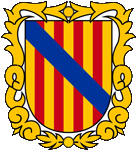
seit 1984,
Wappen der Balearen,
Quelle, nach: Wikipedia (ES)


Wappen des Königreichs Mallorca,
Quelle, nach: fuenterrebollo.com

Wappen des Königreichs Mallorca,
Quelle, nach: eapartybalear.blogspot.com

Wappen des Königreichs Mallorca,
Quelle, nach: Wikipedia (ES)

Das heutige Wappen der Balearen wurde am 21.11.1984 offiziell eingeführt. Das Schild zeigt das Wappen Aragoniens von 1150 (vier rote Balken auf Gold) ergänzt um einen blauen Schrägbalken. Die Farben Rot und Gold gehen angeblich auf den Einfluss des Papstes zurück, denn das alte Königreich Aragon und die Grafschaft Barcelona waren Lehen des Heiligen Stuhls, und verwendeten deshalb die Farben der Stadt Rom. Dieses Wappen taucht auf frühen historischen Abbildungen nicht auf, aber in der Renaissance, als heraldisches Emblem anlässlich der Beerdigung von Karl I. von Spanien im Jahr 1558. Auch das ist rätselhaft, vor allem weil dieses Wappenbild heute als Wappen des Königreichs Mallorca gilt. Aber, es war in der Heraldik üblich, nicht legitime, vom Erbe ausgeschlossene Seiten- und Nebenlinien einer Familie in den Wappen durch einen sogenannten "Bastardfaden" zu kennzeichnen, der schräg über das Familienwappen gelegt wurde. Jakob II. war der jüngere Sohn, Peter III. der ältere. Peters Dynastie wird alles getan haben um Jakob und seine Nachfolger von der Erbfolge (vor allem in Aragon) auszuschließen. Tatsächlich haben sie den Besitz von Jakob II. noch nicht mal anerkannt und seinen Erbteil stets streitig gemacht. Wie dieses Wappen 1978 zum Wappen der Balearen werden konnte ist rätselhaft. Im Jahre 1228 eroberte Jakob I., König von Aragon, die Insel Mallorca, bis 1232 war die Eroberung der Balearen abgeschlossen. Jakob I. gliederte die Inselgruppe als Königreich Mallorca seinem Herrschaftsgebiet an, er war der erste König von Mallorca. Die aus dieser Zeit überlieferten Wappen zeigten im Geviert vier senkrechte rote Streifen auf goldenem Grund (Aragon) und ein blaues Feld mit einer weißen Burg darin. Diese Burg ist die Burg von Palma, der Almudaina Burgpalast, auch Almoraina genannt. Es ist ein in Palma seit der Zeit der Römer ein befestigter Platz in strategisch günstiger Lage. Die Araber (Mauren) errichteten hier im 10. Jahrhundert ihre Residenz, den Alcazar-Palast. Unter König Jakob II. wurde der Alcazar von 1305 bis 1314 zur Königsburg – dem heutigen Almudaina-Palast – umgebaut. Er dient noch heute als Residenz des Spanischen Königs wenn er auf Mallorca weilt. Im Jahre 1269 gestatte König Jakob I. der Universität von Palma seine eigene Flagge und sein eigenes Wappen zu verwenden. Als er 1276 starb, vererbte er sein Reich an seine beiden Söhne. Aragon verblieb bei seinem älteren Sohn Peter III., während sein jüngerer Bruder Jakob II. das Königreich Mallorca erbte und dazu noch die Grafschaften Roselló (Roussillon) und Cardanya (Cerdagne) und die Herrschaft Montpeller (Montpellier). Seine Hauptstadt wurde Perpinyá (Perpignan) in Roselló. Er übernahm das Wappen seines Vaters, jedoch zeigen die historischen Abbildungen von Wappen oder Bannern einen kleinen Unterschied. Die Anzahl der roten Balken verringerte sich auf drei. Flaggen oder Wappen mit diesem Bild nennt man heute "Tribarrada". Die Ursachen dafür sind nicht bekannt. Entweder wurde dem Abzählen der aragonesischen Balken damals keine Bedeutung beigemessen, oder Jakob II. war es wichtig eine eigene Heraldik zu schaffen, die sich von der seines Bruders unterschied.
Quelle: Wikipedia (ES),
teapartybalear.blogspot.com,
Volker Preuß

Die autonomen Regionen Spaniens:
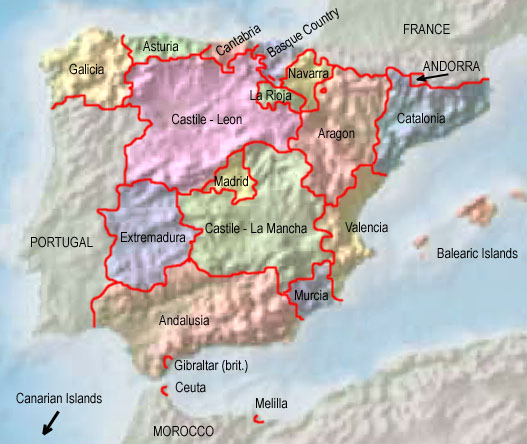
Quelle/Source: Freeware, University of Texas Libraries, modyfied by: Volker Preuß

Fläche: 4.992 km²
Einwohner: 1.176.659 (2022), davon ca. 5% Deutsche, ca. 2% Briten
Bevölkerungsdichte: 236 Ew./km²
Hauptstadt: Palma (Palma de Mallorca), 415.940 Ew. (2022)
Amtssprache: Spanisch (Kastilisch), Katalanisch
sonstige Sprachen: Inseldialekte
Währung: spanische (Euro-)Währung
Zeitzone: MEZ
Quelle: Wikipedia (DE)

4. Jahrtausend v.Chr. · Besiedlung der Inseln
11.–7. Jhd. v.Chr. · die Inseln sind eine Kolonie Phöniziens
3. Jhd. v.Chr. · die Inseln sind eine Kolonie Kathagos
123 v.Chr. · der Konsul Quintus Caecilius Metellus erobert die Inseln (Balearides genannt) für das Römische Reich, sie werden später der Provinz Hispania Tarraconensis angeschlossen, Besiedlung durch Baetiker aus dem Süden Iberischen Halbinsel, Gründung der Städte Palma und Polentia auf Mallorca
425 n.Chr. · die Vandalen unter Gunderich erobern die Inseln
560 · das Oströmische Reich (Byzanz) erobert die Inseln
798 · die Araber erobern die Balearen, zum Emirat von Córdoba (ab 929 Arabisches Kalifat Córdoba unter der Herrschat der Dynastie der Omajjaden
1010 · Sturz der Omajjaden-Dynastie, bis 1040 Zerfällt das Kalifat von Córdoba in mehrere arabische Königreiche (Malaga, Algeciras, Granada, Cordoba, Toldeo, Valencia, Zaragoza, Denia, Murcia und Badajoz), die Balearen kommen zum Königreich Medina bu Taral (Valencia)
1220 · die Balearen trennen sich von Medina bu Taral und werden von einem eigenen maurischen König beherrscht
1228 · Jakob I. von Aragonien erobert Mallorca
1232 · Jakob I. von Aragonien erobert Menorca und Ibiza, Jakob I. gründet das Königreich Mallorca
1232–1343 · Regierungszeit der Könige von Mallorca (Jakob I., Sancho und Jakob II.)
1276 · Tod von König Jakob I. von Aragonien, das Erbe geht an seine beiden Söhne, Aragonien geht an seinen älteren Sohn Peter III., sein jüngerer Bruder Jakob II. erbt das Königreich Mallorca und dazu noch die Grafschaften Roselló (Roussillon) und Cardanya (Cerdagne) und die Herrschaft Montpeller (Montpellier), Hauptstadt des Königreichs Mallorca wird Perpinyá (Perpignan) in Roselló
1343 · König Peter IV. von Aragonien erobert das Königreich Mallorca in den Peterskriegen (Thronfolgekriege), das Königreich Mallorca verbleibt bis 1714 als ein Teil der vereinigten Krone von Aragonien
1469 · Heirat von König Ferdinand II. von Aragonien mit Isabella, der Thronerbin von Kastilien-Leon
1479 · Krönung von Ferdinand II. und Isabella I. zu Königen von Spanien
1516 · offizielle Vereinigung von Aragonien und Kastilien-Leon, Aragonien behält jedoch wichtige Pivilegien
1609 · König Philipp III. verweist die letzten Moslems (Morisken) des Landes
1701–1714 · Spanischer Erbfolgekrieg, Großbritannien besetzt 1708 die Insel Menorca, Aragonien ergreift für Östrereich Partei, nach der Niederlage Verlust der Privilegien, Ende des selbstständigen Königtums der Vereinigten Krone von Aragonien, Katalonien, die Balearen und Valencia werden als spanische Provinzen ausgegliedert
1713 · Frieden von Utrecht, Spanien tritt Menorca offiziell an Großbritannien ab
1783 · Frieden von Versailles nach dem amerikanischen Unabhängigkeitskrieg, Großbritannien muss Menorca an Spanien zurückgeben
1798–1802 · Großbritannien besetzt erneut die Insel Menorca
1808–1812 · die Balearen sind durch französische Truppen besetzt
1931 · Autonomie-Status für die Balearen wird erstmals vorgeschlagen
1936–1939 · Spanischer Bürgerkrieg, die Balearen sind von Anfang an in der Hand der Franco-Truppen und werden eine wichtige Basis im Kampf gegen die sozialistische Zentralregierung
01.03.1983 · die Balearen erhalten das Autonomiestatut innerhalb Spaniens (ehemalige Provinz Palma), Gründung der "Autonomen Gemeinschaft Balearen"
Quelle: Wikipedia (ES),
World Statesmen,
RetroBib Retrobibliothek,
Volker Preuß

Der Name der Inselgruppe der Balearen geht auf die Antike zurück. Die Einwohner der Inseln waren als äußerst geschickte Steinschleuderer berühmt, die sich damit als Söldner auf den Schlachtfeldern der Antike verdingten. In dem Name Balearen (in der Antike Balearides) erkennt man daher das griechische Wort Ballistik. Ältere deutsche Lexika nennen die Inseln auch "Schleudererinseln".
Quelle: RetroBib Retrobibliothek, Volker Preuß


![]()



























